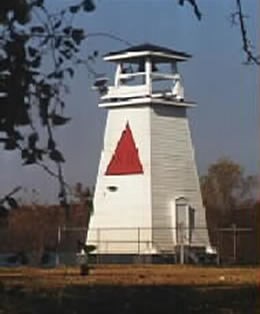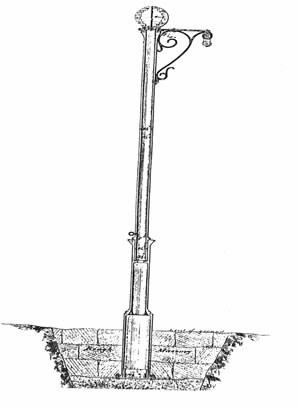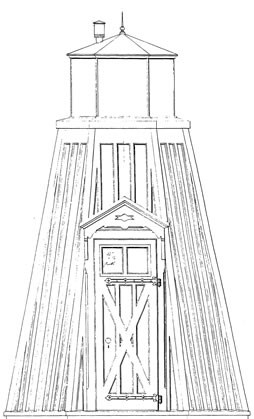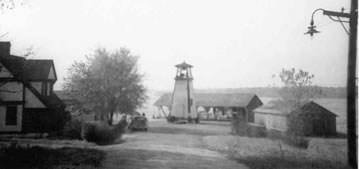
NPS Photo Since man has traveled on the water, it has been necessary to ensure safe passage into harbors. The first light to assist these early mariners would have been a large fire placed on the hillside to direct them to the harbor. Pharos of Alexandria, Egypt can be considered to be one of first lighthouses in the world. This light was constructed over 2,300 years ago and stood over 400 feet high. The light would have been a large open fire with a giant mirror behind it to reflect the glow. The light was lit for over 1000 years and stood unlit for an additional 500 years. During the centuries, invaders and Mother Nature slowly destroyed the once great Pharos. An earthquake finally toppled this Wonder of the World; nothing of it remains today. Lighthouses were first established in the United States along the coast where there were important commercial ports. Since there was no centralized government, many communities would establish there own lighthouse and maintain them. Localism played a large part in placement of the lighthouses; no one wanted to pay for a light in another colony or one that did not benefit the local merchants and people of the area. Until the area became prosperous it was not financially necessary to have a light. As the country grew, more and more lights were placed, and it became difficult for the ship captains to positively locate the correct port. To correct this problem the lighthouse were painted in varying color schemes and the lights themselves were given different patterns of flashing known as "characteristics". Guidebooks to the lights were created so that the captains would be able to distinguish the different lights and find the way into the harbors. With the continuing growth of the country it was necessary to build lights along the major waterways into the interior of the country, these lights placed were secondary to the coastal lights. 
NPS drawing The Potomac River was the waterway into the newly established Capital City, 1800. The river has many water hazards, which could severely damage a ship. The U.S. purchased 6- acres of property from the Digges family to build a fortification to defend the new city. Fort Warburton was established on Digges Point in 1809. The channel for large ships that need to have a large amount for water to stay afloat must come within 50 yards of the shoreline. During the War of 1812 this fort was destroyed, Fort Washington was completed in 1824. As the military reservation grew and river traffic to Washington,DC increased the need for a lighthouse to become evident. The Secretary of Treasury, James Guthrie requested in 1856 that a light be placed on Digges Point. Since this area belonged to the War,Jefferson Davis. Davis agreed to allow a light to be placed with conditions that " the light shall be placed upon the wharf and not within any of the fortifications;and the light keeper shall be subordinate to the military command of the post and public ground in all that relate to police and discipline. If the care of the light can be placed with the Ordnance Sergeant, it will prevent interference with his present charge of other public property." With this permission the Lighthouse Board appropriated $500 for a light. This first light was an 18.5-foot iron post, which was placed November 7,1857. following the recommendations of the Secretary of War the care of the light was placed under the command of the Ordnance Sergeant, Joseph Cameron. Cameron who was joined the Army in 1806 served for 66 years, 37 of these years were at Fort Washington where he died in 1872. Cameron remained light keeper until 1869.

The 1857 light pole remained until the 1870's when growth of the wharf caused obstruction to the light pole. A small 16-foot tower was built closer to the water's edge to replace to light pole. This was considered the first "real" lighthouse and a sixth order illuminant lens was placed in the tower. In 1822, Augustin Fresnel of France introduced a glass lens that revolutionized the lighting of lighthouses. For many years, early American lighthouses burned whale oil as an illuminant in metal lamps and later lamps with mirror-like reflectors. The Fresnel Lens resembled a giant, old-fashioned beehive, inside of which was single lamp. The lens' thick glass prisms bent the lamp's light to the center of the lens', which greatly magnified the light into a powerful beam that could be seen from many miles at night. Fresnel made his lenses in six different sizes or "orders". The 1st, 2nd, and 3rd order lenses were usually installed in seacoast lighthouses to warn ships that they were approaching land. The 4th, 5th, and 6th order lenses were used in harbor and sound lighthouses. A first order lens was the largest, being over ten feet high, and the smallest, a sixth order lens was only 18 inches high and 12 inches in diameter. 


|
Last updated: April 10, 2015
